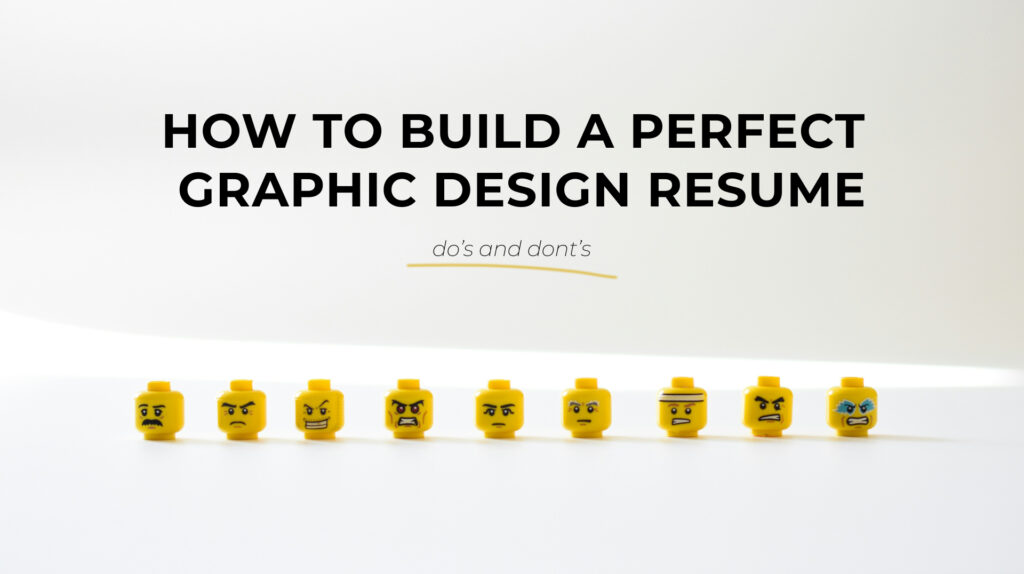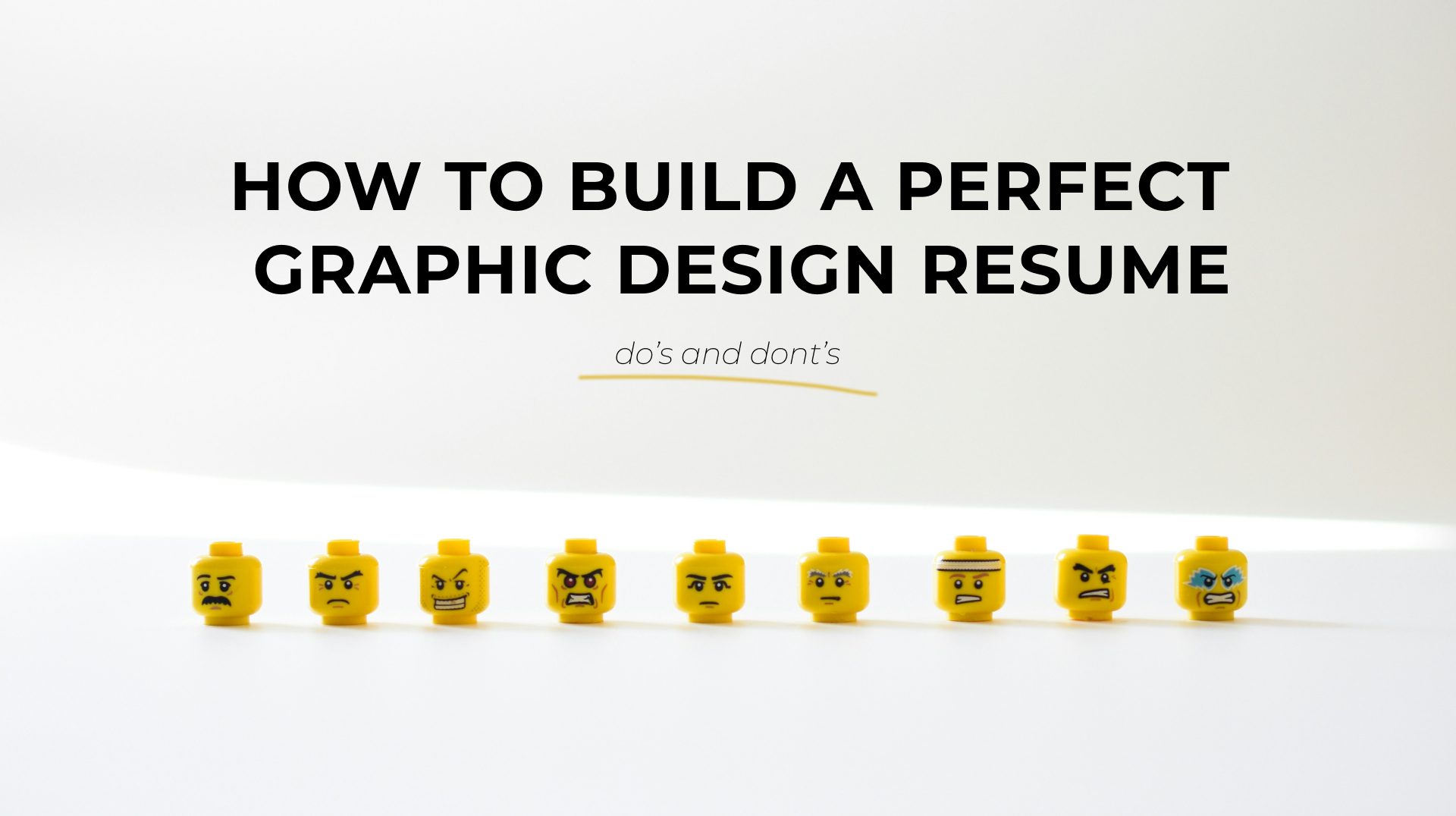You have just finished a lengthy formal education and got your graphic design diploma, shaking with excitement about work in the field you’ve dreamt about for so long. You have a Behance account, a few thousand followers on Instagram, a passionate community, and thousands of saves on Pinterest.
However, what you want is to earn money with what you do, maybe work in corporate or be a freelancer, taking the projects you like and are passionate about. All that requires one more crucial step to take: creating a graphic design resume.
Trust me; I know how big of a headache any resume is to make. Not only do you have to fit all your experience and skills into a single sheet of paper (or make sure the piece of paper looks full), but you also have to make sure the recruiter reads your resume. Half of the things are a chance, and the other are a calculated risk.
So, how do you maximize your chances and calculate your risk to create a resume that will attract the recruiter and give you the job? Let’s talk about the building blocks of your perfect graphic design resume!
Table of contents:
Building a Resume
Think about your favorite Lego set or any Lego set you tried to build in your life. The first step in any of them was always gathering all the packages and blocks together and understanding what the final result is supposed to look like.
Resumes are no different: they also have an art piece that consists of many blocks and a few extra pieces that help tie everything together, creating that gorgeous Lego set that you feel proud of. You should view your resumes in the same way: different packages with blocks inside that, when stacked correctly, create a whole Hogwarts!
So, let’s look at the main packages of the graphic design resume and what blocks are supposed to be inside each of them!
No matter what design project you’re doing next, a Lego set or a graphic design resume, it’s important to make sure that it is flawless. What is a better way to do it than an online proofing software? That’s right; you can approve all of your designs online using annotations, compare modes, artwork cycles, workflows, and more! Learn more about online proofing software and streamline your artwork approval process.
Package #1: Text
The biggest package in our graphic design resume Lego is, of course, the text. It is what the recruiter analyzes during all interview stages and your biggest selling point. You get hired because of what you are, not how you look. Hence, I recommend you spend a whole day or two gathering all the blocks for this part.

It’s not unknown that every resume should match the job almost perfectly. Companies love it when they can see the tailored approach and exact keywords they used in the job description. However, assembling and reassembling the information every single time is a hustle and decreases your efficiency. So what do you do?
Create a document with all the “Lego blocks” representing your skills, experiences, education, and motivations. Then, use it for a resume by simply changing the pasted text and adding more keywords, and voila! A tailored graphic design resume in ten minutes.
So, what block categories do you need for a successful resume? There are five main things that you have to think through:
- Personal Information
- Summary/Career Objective
- Experience (work experience and projects you worked on)
- Skills
- Certifications/school/education
Let’s talk about them in a more detailed way!
Personal Information Block
This one is easy as long as you follow a few rules. First off, be professional. You do not need to include your personal Instagram account, an X handle, or a Snapchat username. The only things you need are your name, active email address, phone number, sometimes a location, and possibly a LinkedIn link. However, there is no point in including LinkedIn if you are not a part of it. Similarly, you don’t have to include your location if the job is remote or they need someone from a specific region.

The thing that must be included, and people sometimes forget about, is the role you are applying for. Recruiters may not notice you mentioning it, however, if you apply for a corporate position and have “Freelance graphic designer” in a resume – you may well forget that you applied there.
Summary or Objective
Summary and career objective are two additional blocks that may strengthen your resume and reduce the white space if you don’t have much experience or projects you can highlight.
Let’s first talk about a summary. Usually, it is a 3-5 sentence paragraph to highlight the most important information in your resume. There are times when recruiters ask for it to be included. However, it is considered a good thing to add it even if not asked specifically. A good summary consists of a few strong blocks, each representing one sentence: your position, your experience, and your best soft skills one and two.

A career objective is similar to a summary but highlights your aspirations rather than your previous experience or expertise. It is not a consistent block of the graphic design resume, however, when you don’t have extensive experience, it might be a nice way of showing off to a potential employer.
Experience
The experience is the most important part of your resume. Therefore, it’s crucial to perfect it. But don’t feel too pressured; I’m going to tell you exactly how to make the sections most effective.
The overall consensus is that when writing a graphic design resume, you should include your last two or three positions that are at least somewhat relevant to the job you are applying for. For example, working in a local coffee shop may not directly relate to becoming a social media designer. However, you can mention that, as part of your role, you created illustrations that increased customer flow by 30%.
If you are a junior graphic designer or lack previous work experience, you can list projects as your experience. What projects, you may ask? It can be anything from helping a friend create a beautiful Canva presentation to any assignments completed during graphic design courses or university. Don’t hesitate to include informal projects if they are relevant to the position you are applying for. Companies seek individuals who are creative in all aspects of their lives. However, remember that each project must demonstrate value. Your Canva presentation should have presented large, complex chunks of information in a fun, easy way. Likewise, the logo you created for the course project should have established a strong brand image.
Don’t hesitate to include any relevant experience, and most importantly, use keywords from the job application. You can create striking Facebook ads, but they require someone to produce effective marketing materials for Meta Suite.
Skills
The next block is graphic design skills. Usually, you include two types of skills in your graphic design resume: soft and hard skills. However, just like with other blocks, these are interchangeable and differ in importance from resume to resume.
Hard skills are things that you can do for an employer: your proficient Photoshop/Figma knowledge, how fast you can type, or how many languages you can speak and work with. For a junior graphic designer, this part of a resume usually has an even bigger value than the experience one does. Here’s why you should think through every single skill you have and have it written down somewhere. List every single software you know how to use, and insert the ones the company is working the most with or the ones you think they can benefit from.

Hard skills should go from the most useful to the least useful for the job you’re applying. However, you should be aware of two possible dangers of the hard skills in the graphic design resume:
- Vagueness – proficient computer skills, for example, can mean “can code” for one person and “good with Microsoft Word” for another;
- Wrong keywords – nowadays, recruiters can use AI to eliminate most people, and using Adobe Creative Cloud instead of Adobe Suite can cost you a job
As for soft skills…Most recruiters seem to not like them for one reason or another. Some say they are too vague and oversimplistic; others say it’s too easy to lie about them on a resume. So, ultimately, it’s up to you whether to add them to a resume. If you do, remember about the same dangers that we have for hard skills – don’t be vague and research the keywords the company would like to see. You can easily find information about the company’s values on their website.
Education
Now, this block is the one that does not carry much weight for a graphic design resume. You see, nowadays, graphic designers do not need a formal education to be great at their job. While it may be a nice bonus, it is not that important compared to other parts. However, it is still customary to include it.
So what do you do? You can take multiple ways to approach this:
- As a junior designer – include it on top of your resume, as this is your best asset right now. As a bonus, if you see anyone on the HR team from the same university, they are going to love a fellow alumnus.
- As a senior designer or a designer without a formal education – you can leave it out if there’s enough experience to showcase. Alternatively, you can include it at the very bottom of your resume. For senior roles, education is not as important unless it is a very niche course you’ve taken that the company specifically searches for.
Package #2: Design
The second block package is smaller but definitely not less important. Let’s talk about the design of your resume!
You may think that the resume is a place to show off how great you are at designing. Maybe you were thinking about giving it some funky colors along with some cool shapes here and there just to give the recruiter a glimpse of your personality. I’m sorry to break it to you, but that is not the greatest idea. Let’s talk about hiring bias.

Every single recruiter is a person (surprising, isn’t it?). As people, we are inclined to have momentary biased impulses. No matter what you think or know logically, those impulses are different because they stem from all the deeply rooted stereotypes in our society or our personal preferences. We have learned to understand that some of those impulsive thoughts are wrong. However, our brain needs time to understand that. In resumes, it’s usually about preferences, the recruiter not liking purple, and the resume having some purple design on it. Logically, it is clear that that is not a reason to reject a perfectly good candidate.
However, the recruiter spends around seven to nine seconds on an initial resume screening. Chances are that the initial bias against purple will win over. If you don’t believe me, try opening a random resume from Canva and accessing it for 15 seconds. Difficult, isn’t it? Notice how you have almost no time to access the resume logically, it rather feels like an impression game.
For this reason, it is important to keep your resume as simple as possible design-wise. Plain text, bullet points sans serif font for the main text and the simplest serif for headlines with optional sparks of color around the main parts of the resume. That is all you need for a successful resume.
If in doubt, try showing your resume to a few friends for 10 seconds and then asking them to recite information from it. If they managed to get all the crucial info – congratulations, you created the most efficient resume template.
Package #3: Add-Ons
Unlike most jobs, graphic designers require at least one add-on to their resume. Of course, it’s a portfolio. For a graphic designer, a portfolio is the block. The portfolio is the hands-on evidence of all that experience that you described in the resume, and here, you can use any tricks you think will help.

Let your creativity flow with the portfolio design, show your personality to its fullest, and structure all the projects you can showcase neatly. There’s not much to say; just do not forget to add a link to your portfolio in the resume so your work is not wasted.
Another add-on that a job application might require is a cover letter. For a successful cover letter, you do not need too much. Remember we talked about your career objective? You can easily do the same but in a longer format. A cover letter should indeed be customized, but you can easily brainstorm some good sentences to include and then tie them with the soft skills the company requires from you and some good ol’ praising. If you are interested in cover letters, let us know, and we will discuss this topic in more detail.
Final thoughts
I know it was long. However, this may well be the only guide you will ever need to create a graphic designer resume. Remember, the main rule here is to understand exactly what the company needs from you and cater to their needs. And do not forget about applying for fun, even if the chances seem slim. I know many people who got their jobs by randomly applying for the jobs they thought they were underqualified for. So, believe in yourself, be confident, and you will get that job! And don’t forget to recommend Approval Studio to your future employer for the best proofing software there is.

 TEAM SOLUTIONS
TEAM SOLUTIONS WORKFLOW SOLUTIONS
WORKFLOW SOLUTIONS



 REVIEW TOOL
REVIEW TOOL PROJECT MANAGEMENT
PROJECT MANAGEMENT TOOLS & INTEGRATIONS
TOOLS & INTEGRATIONS
 CLIENT INTERVIEWS
CLIENT INTERVIEWS









